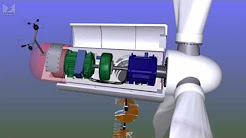Our step-by-step process assures timely completion:
Pre-construction
Wind Study: We rigorously analyze a proposed site using our own proprietary algorithm based on data from AWS Truewind WindNavigator, the NREL IMBY Wind Resource Calculator and California irrigation data. We then offer projected wind availability throughout the day and the seasons to project expected electricity generation.
Financial Sensitivity Analysis: We determine whether the project will be financially viable for our customer and for Foundation Windpower. Typically we will not bid a project unless we can offer a discount to existing and projected utility rates.
Financial Overview & Cost Savings Analysis: We project customer savings based on varying wind conditions and historic utility rate increases.
Construction
Permits: We handle the complete permitting process. Our in-depth knowledge of government agency concerns and requirements keeps this activity moving forward.
Engineering: Our partners survey customer property and needs to determine the best possible site then develop plans for installing the base and wind turbine tower(s).
Planning for implementation: Working with the customer’s management, we develop budgeting and timelines to minimize construction time and any possible disruption to the facility.
Team Selection and Briefing: We put the right team together from among our construction partners and go over all conditions and concerns before bringing a crew on site.
Construction and Completion: We excavate and pour the foundation, erect the tower and install the blade and make all electrical connections. Then we test the turbine before commissioning it to generate meaningful energy savings.
We know you have questions. You will find many answered below. We’d be delighted to provide you with more detailed information.
What expenses do Foundation customers incur?
There are no capital costs to the customer. Foundation Windpower pays for all development costs and capital expenses related to the project. Customers may have minimal internal legal or closing costs. Turbines are delivered, installed, and commissioned at Foundation’s expense.
Who pays repair, maintenance and operational costs?
Foundation Windpower pays all costs associated with operating and maintaining wind turbines for the full project lifetime.
How does the customer save money?
The customer purchases all wind power generated on site at a rate lower than their current utility rates. Customers save on standard energy charges year after year. Over the lifetime of the contract some customers will save millions in energy costs.
What about impact on the environment?
According to a U.S. Department of Energy report, wind power can displace substantial amounts of coal and natural gas fuels. If 20 percent of American electricity is wind generated, by 2030 we would reduce CO2 emissions by 825 million metric tons.
Is a facility disrupted by construction the tower?
Operations remain uninterrupted since construction takes place near but outside of working facilities.
Can the project lower customer peak demand charge expenses?
Yes. If the customer’s load profile permits, the project will make a site eligible for a renewable-only rate tier (SCE Option R or PG& A6) with greatly reduced peak demand charges.
What happens if the wind underperforms expectations?
The customer never loses money. However, total customer savings would decrease proportionally, since there would be fewer discounted kilowatt-hours available to purchase from the project.
What happens in the event of a disaster, which causes turbine failure?
Foundation fully insures the turbine at its own expense.
How long does the process take?
6-18 months from the first expression of interest to an inter-connected wind turbine. The variability is based on how long the customer takes to approve the project internally, what permitting process is used by the local government and the equipment availability. Construction is usually completed in two separate 2-week periods (one for site preparation and foundation construction and one for turbine erection and commissioning).
How much wind is required to make a project feasible?
The site will need a minimum of 5.5m/s of wind to operate.
Do you only operate in California?
Although all projects are currently based in California, we are able to look at projects in other states.
What happens at the end of the Power Purchase Agreement?
There are two options available to customers, the first is to extend the Power Purchasing agreement if the turbine is in good condition and the second is for Foundation Windpower to decommission the turbine at their own cost and restore the site to its original state.
How about bird life in the area?
Recent research from the scientific community supports the premise that wind energy is less hazardous to avian wildlife than traditional fossil fuel generation. Modern wind turbines utilize low rotational speeds, which allow birds to see and avoid the blades. Furthermore the turbines utilize single-pole towers, leaving birds no place to perch or nest on the turbine structure. One recent study compared wind power bird kills per GWH of electricity generated with that of fossil fuel generation, which kills birds due to fuel mining, high-tension power lines, acid rain and other pollution, and global warming-induced loss of habitat and food chain disruption. It concluded that wind turbines kill an average of 17 times fewer birds per GWH generated than traditional fossil fuel generation. A recent USDA Forest Service report estimated 2005 wind-turbine bird kills at 28,500, in contrast to 550,000,000 killed by buildings and 100,000,000 killed by cats.


